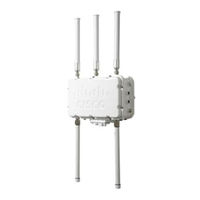Cisco Aironet 1550 Series Access Point Manuals
Manuals and User Guides for Cisco Aironet 1550 Series Access Point. We have 4 Cisco Aironet 1550 Series Access Point manuals available for free PDF download: Deployment Manual, Installation Manual, Hardware Installation Manual, Getting Started Manual
Cisco Aironet 1550 Series Deployment Manual (276 pages)
Cisco Mesh Access Points, Design and Deployment Guide, Release 7.3
Brand: Cisco
|
Category: Wireless Access Point
|
Size: 10 MB
Table of Contents
Advertisement
Cisco Aironet 1550 Series Installation Manual (164 pages)
Outdoor Mesh Access Point
Brand: Cisco
|
Category: Wireless Access Point
|
Size: 7 MB
Table of Contents
Cisco Aironet 1550 Series Hardware Installation Manual (162 pages)
Outdoor Mesh Access Point
Brand: Cisco
|
Category: Wireless Access Point
|
Size: 6 MB
Table of Contents
Advertisement
Cisco Aironet 1550 Series Getting Started Manual (59 pages)
Outdoor Mesh Access Point
Brand: Cisco
|
Category: Wireless Access Point
|
Size: 2 MB



